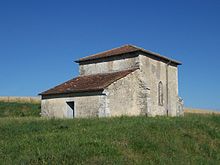|
Gibrian
Saint Gibrian (or Gybrian, Gobrian; died 509) was an Irish saint associated with Reims and the Marne region. LifeGibrian's story appears in the fourth book of the Historia Remensis ecclesiae ("History of the church of Reims"), which was written by Flodoard in the tenth century. Gibrian is mentioned as one of a group of siblings from Ireland who were received by St Remigius at Reims, the seat of his diocese, and given permission to settle in the Marne region. They are said to number seven brothers, Gibrian, Helan, Tressan, German, Veran, Abran, and Petran, and three sisters, Francla, Portia, and Promptia. Gibrian chose for himself a spot near Châlons-sur-Marne in what is now the commune of Saint-Gibrien, which derives its name from the saint.[1][2] Gibrian died in 509 and a small chapel was built to mark his grave. Flodoard further writes that Normans destroyed the chapel in the ninth century, but that the body was left intact and following a series of miracles[further explanation needed] at his tomb, his relics were translated to an altar at Reims.[1] Other versions of this account were later told in Gibrian's and Tressan's Lives, which James Kenney regards as "late and fabulous compositions".[2] CultWhile the matter of Gibrian's sanctity was not in danger, it was not until the mid-12th century that he began to attract a cult at Reims. This was due to the work of Odo, the abbot of Saint-Remi, who sought to support the new monastery of Chartreux in Champagne. In 1145, Odo had the saint's relics moved to a new shrine at the new monastery. As many as 102 miracles were recorded between April 16 (the day when the relics were translated) and August 24, mostly on Sundays and feast-days.[3][a] There is no sign of a popular cult for a long while afterwards,[specify] but it had a revival in 1325, when the saint's reliquary was replaced with a more significant one, the place becoming a place of interest for pilgrims.[4] Monks of Ramsgate accountThe Monks of Ramsgate wrote in their Book of Saints (1921),
Butler's accountThe hagiographer Alban Butler (1710–1773) wrote in his Lives of the Fathers, Martyrs, and Other Principal Saints under May 8,
Notes
Citations
Sources
|
||||||||||
Portal di Ensiklopedia Dunia
